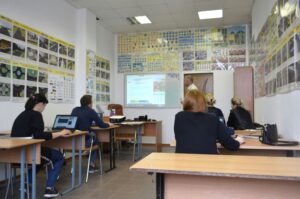
(Photo by Element5 Digital on Unsplash)
If you grew up in Canada, there is a good likelihood that you went through the K-12 education system. In fact, for people aged 25-34 in Canada, only about 5% did not graduate from high school (Statistics Canada, 2023). While for most of us, this is a normal part of life, for many, this is a reality that they can only dream of. Currently, roughly 17% of children around the world are not enrolled in any school activity, with higher percentages in developing nations (Schmelkes, 2020). Many of these children live in rural areas, which simply do not have the resources for the children to receive education due to disparities in educational funding from governments regarding rural vs. urban environments. Even beyond K-12, post-secondary education in countries such as Canada has to be paid for by the student, this creates a large barrier to education in that those who cannot afford to pay for the education must choose between taking on debt to pay for education or choosing a new path. It is this issue of educational inequalities that the paper, The Impact of Openness on Bridging Education Digital Divides, addresses and explores to determine ways in which open educational resources (OER) can be utilized to improve educational access.
What are Open Educational Resources and Openness?
So we’ve now heard that OER can be beneficial to reducing educational barriers and improving access to education, but what exactly are they? Simply put, OER are things for learning, teaching, and research that are in the public domain or are under an open license (UNESCO, n.d.). For example, MIT OpenCourseWare contains a large library of OER from MIT for any person to access. Another important concept from the paper is that of openness. Openness is key to OER in that it is primarily involved with the open licenses of the resources. The paper highlights that openness has different meanings in OER and that the ‘O’ in the acronym can mean any of these:
- Open Access
- Open Licensed
- Open Format
- Open Software
While each of these aspects of openness is important for OER, missing one can cause issues regarding how open the OER is. The paper uses the example of MS Word, where a .docx file in the software can be easily shared with the open license, however, the software itself is not open source, so for others to use the file in MS Word, they would need to purchase the software for full functionality. This highlights a concept of maximum openness, where to achieve this maximum openness, the OER must contain the four different aspects of openness mentioned above.
How do OER Improve Educational Access

(Photo by Ilya Sonin on Unsplash)
Now that we understand what OER are, how can they be used to improve access to education? Well, the paper highlights several factors that could be beneficial for improving educational access. One point is that of cost barriers. One of the major benefits of OER is that, in principle, they are completely free of charge. I know that I am not alone with the annoyance of high prices of university textbooks, which have no doubt led to many people simply avoiding the purchase of them. OER simply gets rid of this issue by supplying course materials and textbooks that are free of charge, which is something everyone who has ever had to buy a textbook could get behind. This also opens the door to many who could not pay for education, or, as the paper highlights, perhaps preferred to study in isolation due to social or cultural pressures, increasing their educational access.
Another large factor is that of access and the increased availability OER gives. As OER is published on the internet, anyone with internet access can access the educational materials. In places where physical textbooks or other educational materials are rare or hard to access, this drastically improves these people’s ability to learn and gain access to education. As mentioned above, cost barriers are not the only factor at play when it comes to educational access, in fact, in cases of disempowerment, the author argues that social and cultural factors are more impactful than economic ones. For example, if someone was denied access to education in a formal setting, they may still have the ability to learn through OER.
Challenges Regarding OER

(Photo by Dreamlike Street on Unsplash)
While OER does have many benefits as mentioned above, it no doubt has its many issues. A common theme in the paper is that of access. OER are published online, which immediately disqualifies anyone lacking internet access from accessing the educational materials. This is a major challenge for OER, as one of the touted benefits is increased global education, however, it stems from a reliance on a technology that not everyone has access to in the first place. For many people, beyond the internet, they do not have access to the devices themselves that they would use to gain internet access. For many, the reason ties back to costs. In my opinion, this makes OER a free* resource, where the asterisk represents the prior requirements needed to access OER, such as a computer and internet access. However, as is mentioned in the paper, digital devices are coming down in prices every year, which ultimately increases the availability of OER and as time goes on, perhaps this will become less of an issue.
Another challenge brought up is that OER often lack any sort of intermediary, or in other words, teachers to support their education. The author argues that less sophisticated students may struggle to make use of OER without support from intermediaries. My own opinion of this matter differs slightly. While I do believe it is true that lacking an intermediary could prove to be challenging, I do not believe this would make the OER more difficult to use. A person with internet access has access to so much OER content and other supporting content (YouTube tutorials, for example) that a person utilizing OER could use to support their learning. For example, a person using an OER textbook on pre-calculus has access to an incredibly wide range of internet support to supplement their OER textbook and learning. Regarding this, it is important to mention the paper is from 2009, and since this time, much has changed regarding the digital landscape for education that could not have been predicted.
Conclusion
OER has huge potential, it can provide people who would never be able to access educational resources the ability to learn. While economic constraints are a major issue, factors such as social and cultural pressures can be more impactful on a person’s education when in a disempowered position. And while there are major benefits to OER, challenges still arise, we have seen that OER has an issue of reliance on technology that not every person has access to, creating a digital divide. Along with this, OER lacks any sort of intermediary, such as a teacher, which the author argues can lead to issues with utilizing OER. Overall, OER has huge potential to reshape education and for many has already played a huge role in their life, no doubt and with the reduction of prices of devices to access the internet, there is even more potential for OER in the future.